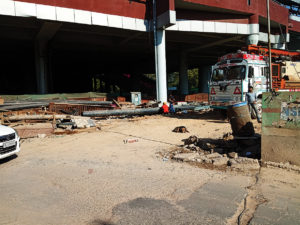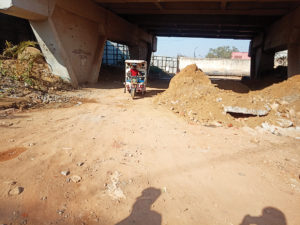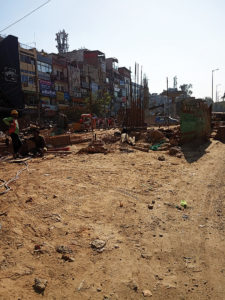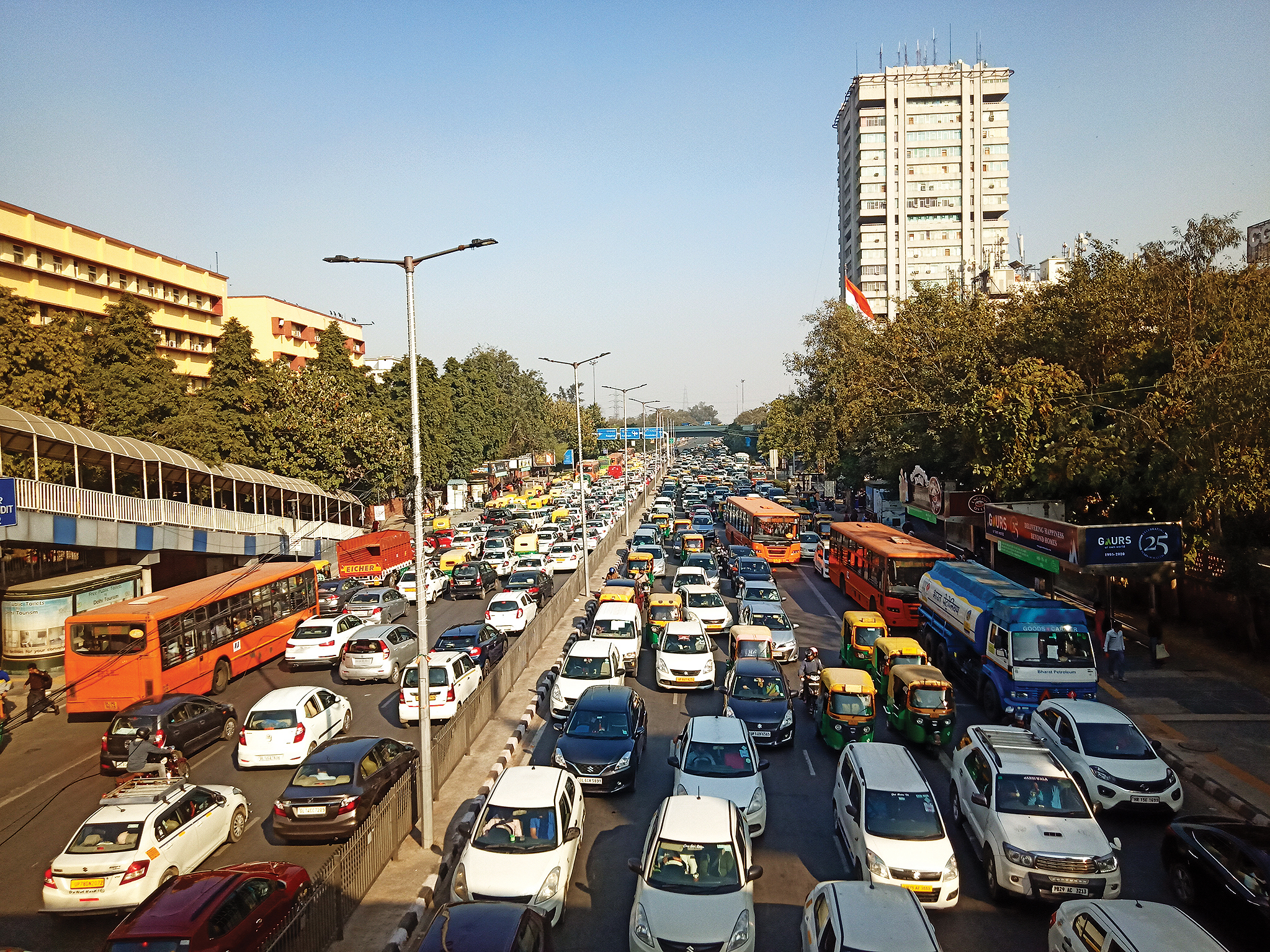Shaheen Bagh protesters are being demonised but delays by authorities are responsible for most bottlenecks
SHAHEEN BAGH hit the headlines for blocking one major road that links Noida with Delhi. But the bottlenecks which have been holding traffic for hours do not find any space in the news. There are various spots in Delhi where commuters have to suffer due to construction-cum- bottlenecks.
We met Sandeep Kumar, a labourer, at Ashram Chowk Bus stop as he waited for bus number 460 towards Badarpur border. It was 9:45 in the morning, peak hour, which meant it took almost half an hour for the bus to come. “I usually take this bus and have to wait for hours for the bus due to traffic. My journey which should be of 20-25 minutes, takes an hour. Traffic here is always high. But it does not work as an excuse for me to reach late at my site, my wage would get cut,” says Kumar who hails from UP’s Jaunpur.
Ashram Chowk is just one of Delhi’s high traffic bottlenecks, commuters have to wait for hours even during general hours. To resolve this problem PWD is constructing an underpass to divert over 40 per cent of the traffic on Mathura road. M/s Dharmraj Contracts is handling the project and the estimated cost of the project is Rr 49,07,37,768. Work for the 750- meter long underpass started in July 2019, with the deadline set for July 2020.

The PWD is also undertaking the project to extend the Ashram Flyover to Delhi-Noida-Delhi (DND) flyover. Chief Minister Arvind Kejriwal said while laying the foundation stone for the project, “We are constantly working to address and eliminate the issue of traffic congestion across various locations. We have to improve the transportation sector in Delhi. The responsibility of identifying and creating a list of all the congested spots which lead to traffic jams in the city will be handed over to an agency.” But so far no news on any such agency has come.
This construction has hit traffic around New Friends Colony, Lajpat Nagar, Jangpura, and Nizamuddin. As per traffic police data, every day over three lakh vehicles cross the Ashram intersection during peak hours. One can hear this noisy and annoying atmosphere even from inside Ashram Metro station. The sound of construction work, vehicles, along with pollution makes the place tough to tolerate for long. During our visit we saw an ongoing project of IGL (Indraprastha Gas) pipeline, which was also causing a temporary bottleneck, as each time a DTC bus stopped, no vehicle could pass by.
Manoj, a vendor near the bus stop echoed the much-publicised narrative: he said, “This traffic is due to the roadblock at Shaheen Bagh.” Even the head of traffic engineering and safety division at Central Road Research Institute, Subhash Chand, cited the same reasoning: “Road no.13 (A) is blocked therefore the traffic volume has increased there, which is temporary.” But even when the Kalindi Kunj road was open, traffic was a big issue on Ashram Chowk as its a connecting route to Noida and Faridabad.

Santosh Singh, an auto driver, blamed car owners, “In Delhi, people have cars even when they do not possess a home. I ferry people around in Delhi, and now there is no place where you do not find traffic and this Ashram Chowk is even more irritating. But traffic is the story of entire Delhi now if you take that Pragati Maidan Road or go towards Purani Delhi, traffic is everywhere.” As per Economic Survey of Delhi (2017-18), there are 556 vehicles per thousand people which reflects how disastrous this traffic problem can be.
Another disgruntled resident, Prakhar Singh, who lives at Patel Nagar told us about his commuting woes. A student, Singh gave us an example of bad traffic management. He said traffic police did not allow him to take a U-turn at Goswami Giridhar chowk near Shadipur metro station. He then had to go a kilometre further towards Kirti Nagar and then took the U-turn under the Shadipur flyover. But then he found that the underpass is still under construction, and there were no boards cautioning motorists about it.
Surendra Binani, who sells gutka and cigarettes just outside Shadipur Metro said, this has been going on for year, “I have been seeing this for four years. I am not sure how long it will take.”
The same story was of the construction work at Pragati Maidan. The ongoing work for five underpasses and a tunnel as a part of the Pragati Maidan redevelopment plan has been a headache for commuters.The 1.2 km tunnel is being developed by Larsen & Toubro with an estimated cost of 777 crore. And the other companies involved in construction activities are Shapoorji Pallonji, ITPO, NBCC. This bottleneck affects Mathura road, Ring Road, and Bhairon Marg. The deadline set for it is March 2020.

We then went to Delhi Universities South Campus. Here we met Gautam Mehta, a student of Moti Lal Nehru College who told us that no bus stops outside his college, while the Bus numbers 507, 611, 629 are mentioned on the bus stop. This is because an underpass underconstruction near Venkateshwar College. The three-lane underpass is part of the Rao Tula Marg redevelopment project and is being developed by PWD. It has already missed six deadlines.
Construction projects often miss deadlines. For example, Rao Tula Ram (RTR) flyover at the crossing of outer Ring Road missed the deadline for two years. The reason cited by authorities was that they were not allowed to cut trees. A PWD official told us without revealing his name, that construction work often gets delayed due to various factors like shifting utilities and clearances. He even blamed the ban on construction work as a factor for delays, saying that “In Delhi, you see that every winter construction work has to be stopped due to pollution.”
The compensatory planting of trees is still going on at RTR flyover which is creating another temporary bottleneck. The RTR flyover was built to ease commuting from South Delhi towards the Airport and Gurugram, but failed to do so because it is a single carriageway and second, the road under the bridge is narrow and the ongoing construction hinders the smooth passage of vehicles.
Surendra Kumar, an auto driver who often visits that area said he denies rides towards Vasant Kunj and Munirka during peak hours.
Traffic is not just an issue at major roads, it has a deadening effect at local roads too. When commuters travel from Sant Nagar via Lok Marg toward GTB Nagar Metro, traffic becomes a major cause of worry. It happens in every densely populated locality in Delhi, and the factors responsible include the increasing number of vehicles, street vendors, encroachments, constructions, amongst others.
Chand blames the congestion on lack of coordination between the agencies: “Two agencies are involved in traffic management, one is traffic police and second is the municipal corporation. Nobody dares to deal with encroachment — vendors occupy places, which is the story at every traffic bottleneck, who will remove them? Concrete action is required to deal with it after doing proper research, which has not been done so far”.
He adds, “Infrastructure to deal with traffic can be created and it is being created. But who will ensure that this will not be misused? Media should highlight misuse of infrastructure by people who are encroaching on public property.”

In July 2018, the Delhi government gave a timeline to the Supreme Court about decongesting traffic at 77 bottlenecks. The affidavit submitted to SC talked about short term measures to reduce traffic like improvement in road geometry which will take six to eight months and “long term” measures like over bridge, underpasses, and U-turns to be finished in 12 months.
Delhi police commissioner was also summoned by Supreme Court over non-implementation of recommendations of a task force for removing traffic bottlenecks and encroachment. Delhi Police replied that they will first target 28 highly congested bottlenecks, completing this work by December 2020. A task force earlier constituted by the Lieutenant Governor categorised these traffic bottlenecks into three categories: 28 highly congested ones which fall under category A, 30 congested ones are of category B and 19 mildly congested ones which fall under category C.
The court then said, “We expect all authorities concerned to ensure that the timelines are adhered to without fail and we also expect the commissioner of police to ensure that these timelines are adhered to by all. In case the commissioner of police finds any difficulty with any of the authorities…he is at liberty to move an application in this court. We expect the heads of these authorities to cooperate.”
It seems unlikely, however, that the Delhi government would be able to remove traffic bottlenecks in the stipulated time frame as various construction projects are missing the deadlines, even as number of vehicles on the roads of Delhi keeps rising.
Taking a jibe at these constructions and traffic situation, Rambabu, who was standing at Munirka watching JCB digging a hole on the road said, “Yahan bhi Khuda hai, waha bhi Khuda hai, jahan nahin Khuda waha kaam chal raha hai” (God is everywhere but not where there is digging going on).





